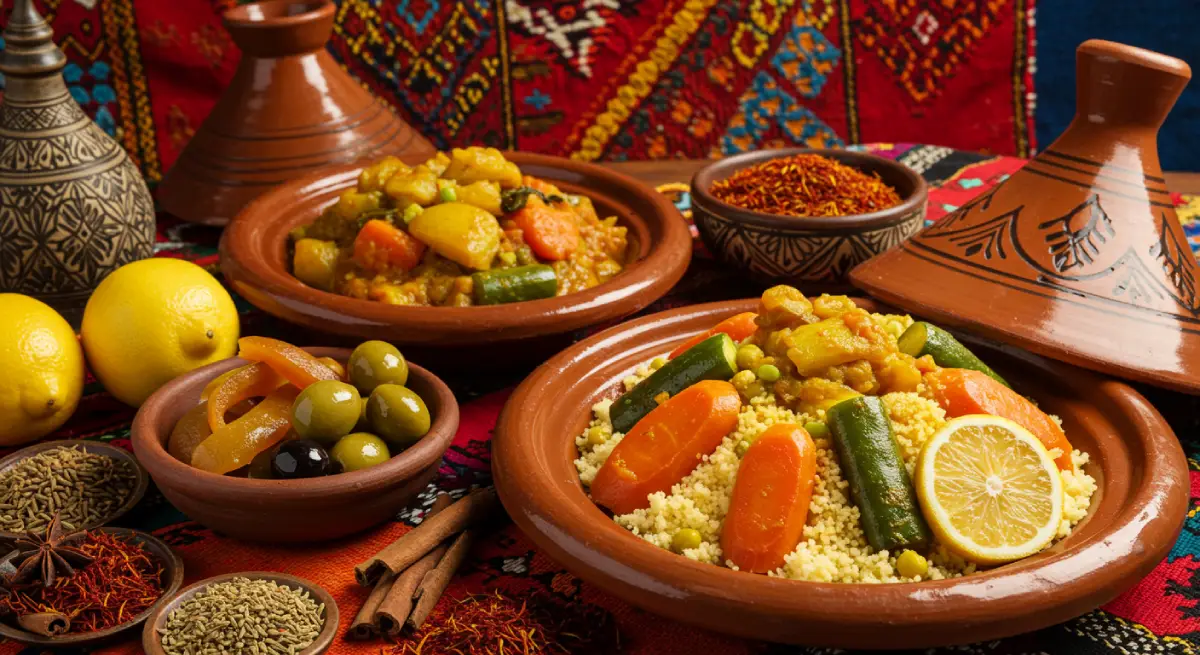Table of Contents
🟩 Vibrant Moroccan Cuisine: Where Tradition Meets Funky Flair
Step into the colorful world of Moroccan cuisine, where centuries-old traditions are being reborn with a modern, funky twist. 🇲🇦✨
From spice markets in Marrakech to kitchens worldwide, this fusion of North African flavors and contemporary creativity offers an exciting new way to experience food.

Whether you’re an adventurous home cook or just starting your culinary journey, Moroccan cuisine welcomes you with warmth, color, and bold taste. Think of it as a celebration that invites you to mix classic ingredients like preserved lemons, ras el hanout, and saffron with imaginative touches like apricot chutney or avocado crema.
🟨 The Soul of Moroccan Cuisine: More Than Just Food
Moroccan cuisine is more than a collection of recipes — it’s a rich expression of cultural heritage, Berber roots, and Mediterranean influences. Every dish tells a story, blending ingredients like chickpeas, olive oil, and spices that have nourished communities for generations.

This culinary tradition is primarily known for its slow-cooked tagines, prepared in iconic clay pots that preserve moisture and enhance flavor. These dishes aren’t just meals — moments meant to be shared.
If you’re new to tagine cooking, check out our guide on how to master your first Chicken Tagine with Preserved Lemons and start your Moroccan journey.
🟧 The Funky Side: Reinventing Classics with Confidence
What makes this version of Moroccan cuisine truly stand out is the funky flair — playful interpretations that keep tradition alive while allowing room for creativity. Imagine:
- Spiced lamb sliders with ras el hanout and a tangy apricot glaze
- Roasted carrots drizzled with harissa-honey glaze
- A classic tagine served over quinoa instead of couscous.
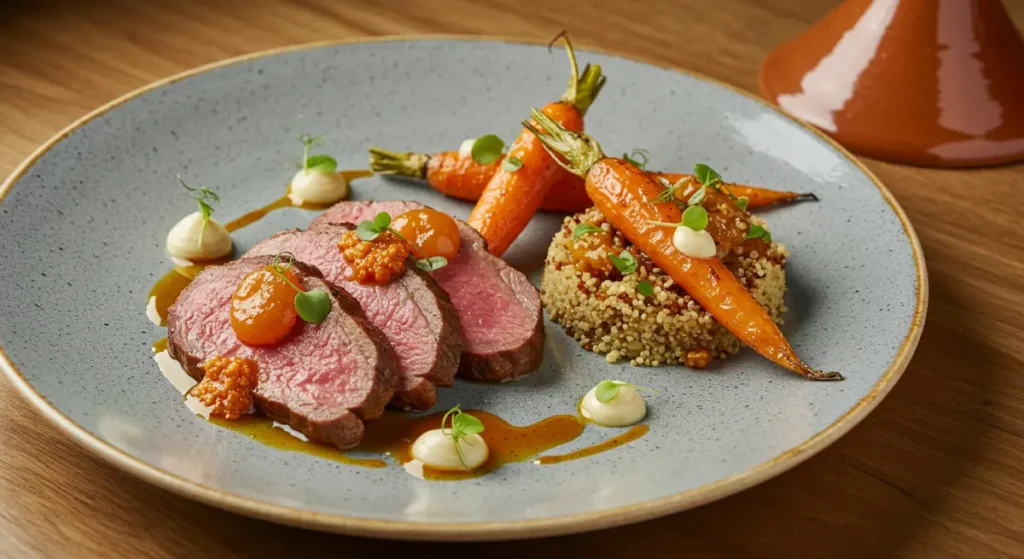
These updates don’t dilute the authenticity; they elevate it. They invite more people, wherever they live, to explore Moroccan flavors in ways that fit their lifestyles.
✨ According to Harvard T.H. Chan School of Public Health, Mediterranean-based diets like Moroccan cuisine are linked to better heart health, improved digestion, and reduced inflammation — making these vibrant dishes as nourishing as they are flavorful.
🟪 Moroccan Cuisine for Every Skill Level
One of the most beautiful aspects of Moroccan cuisine is its adaptability. You don’t need professional training or exotic tools to start cooking. All you need is:
- A few staple spices: cumin, cinnamon, turmeric
- Base ingredients like onions, garlic, olive oil, and fresh herbs
- A desire to explore a cuisine that’s equal parts soulful and exciting
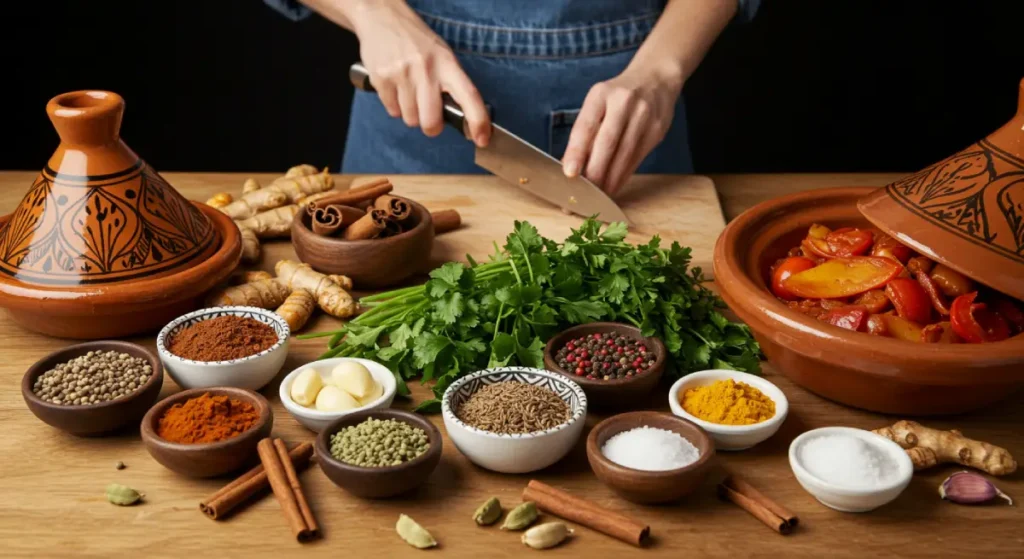
And if you don’t have a traditional tagine pot, that’s no problem. A Dutch oven works just fine for your first try. What matters most is the intention—to slow down, layer flavor, and honor the process.
🟦 Bringing Moroccan Food Culture into Your Home
As Moroccan cuisine continues to gain popularity worldwide, more home cooks are discovering that it’s not just delicious — it’s also deeply communal and joyful. 🌍💚
You can start small with a one-pot tagine or go big with a full Moroccan spread for special occasions. Set the mood with vibrant textiles, traditional Moroccan music, and a pot of mint tea. You’ll create a meal and craft a culinary experience that honors both the past and the present.
🟩 What Makes Moroccan Cuisine Enchanting?
At the heart of Moroccan cuisine lies a fusion of vibrant spices, earthy herbs, and Mediterranean influences that create a culinary symphony. From the aromatic allure of saffron to the zesty tang of preserved lemons, each dish offers a sensory experience. Moroccan food is not just about the ingredients, but the story each meal tells — transporting you from the spice markets of Marrakech to intimate family gatherings where food is shared among loved ones.
Whether it’s the rich, spiced lamb or a humble vegetable tagine, Moroccan dishes embrace a balance of sweet, savory, and spicy. The complexity and depth of flavors are a direct result of centuries-old traditions, where spices like cumin, cinnamon, and saffron harmonize in perfect unity.
🟨 The Magic of Spices and Herbs in Moroccan Cuisine
What sets Moroccan cuisine apart is the dazzling variety and rich depth of spices and herbs used in every dish. Essential to its identity, these ingredients define the flavor profile of Moroccan food. Cumin, coriander, cinnamon, and paprika are just the beginning.
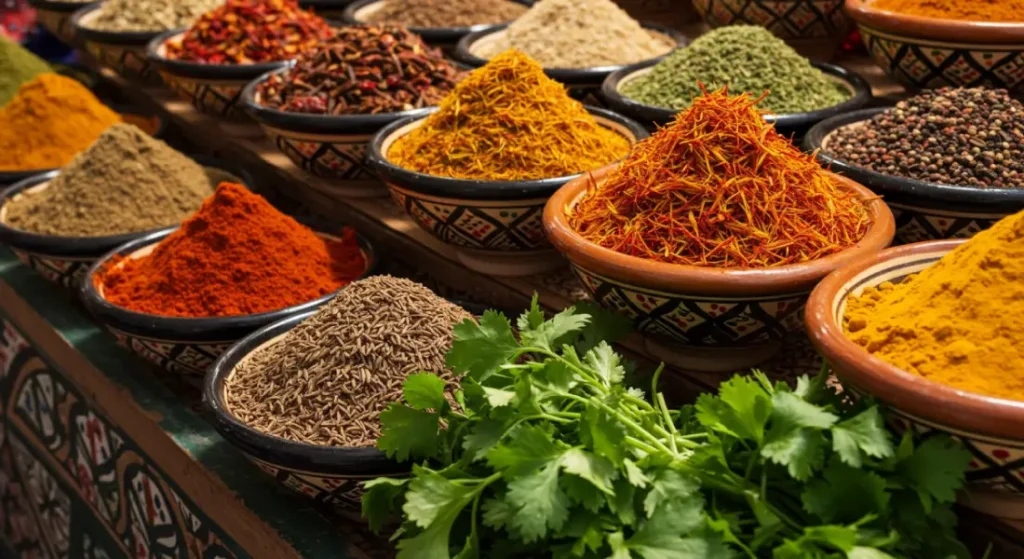
- Saffron, revered for its subtle yet deep flavor, adds a touch of luxury and color to dishes like chicken tagine or couscous.
- Cumin, on the other hand, imparts an earthy warmth. It is often used as the base for Moroccan spice mixes like ras el hanout.
- Cinnamon, commonly used in sweet and savory dishes, gives Moroccan food its signature comfort and richness.
These flavorful elements create a cuisine as layered as its history, where each spice brings a new dimension to a dish. Combining sweet, savory, and spicy, Moroccan cuisine strikes a delicate balance that’s comforting and exciting.
🟧 Preserved Lemons and Olives: The Heart of Moroccan Cuisine
Preserved lemons and olives are iconic ingredients in Moroccan cuisine, deeply rooted in tradition and essential for crafting authentic Moroccan dishes. Preserved lemons, which undergo a fermentation process with salt and spices, add a unique combination of tartness and complexity that elevates tagines and stews.
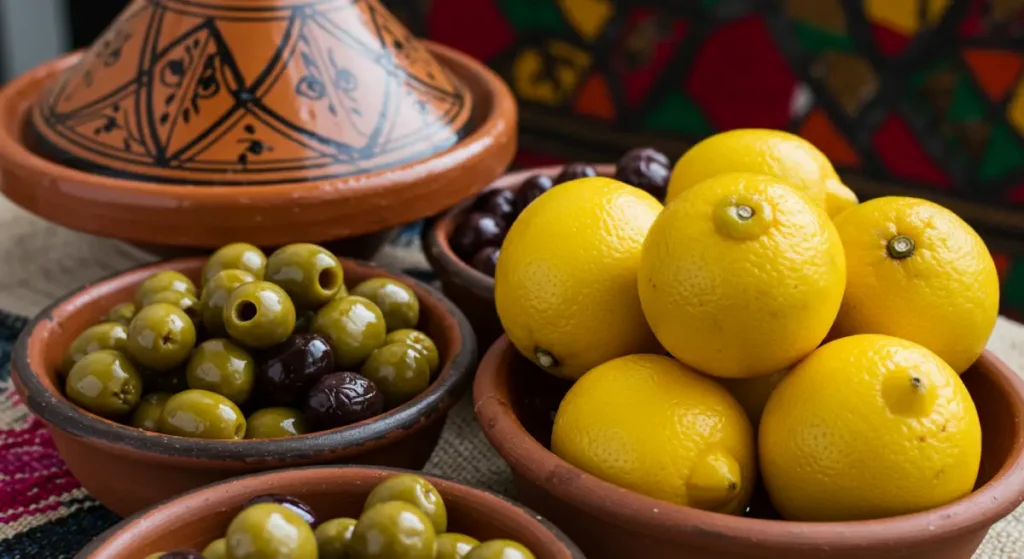
Olives, which are abundant in Morocco, come in many varieties—from briny green olives to richer, more savory black olives. Combined, these ingredients add a zesty, tangy kick that balances the richness of meats like lamb and chicken.
One of the most beloved dishes showcasing these ingredients is chicken tagine with preserved lemons and olives. It’s a dish that captures the soul of Moroccan cuisine: simple, aromatic, and rich in tradition.
🟪 The Essence of Moroccan Tagines: Slow Cooking at Its Best
A tagine is not just a dish — it’s a symbol of Moroccan cuisine. The iconic clay pot used to cook tagines is designed to keep moisture locked in, creating tender meats and intensely flavorful stews. The slow cooking process is central to Moroccan cooking, allowing the spices to meld and infuse into every ingredient.
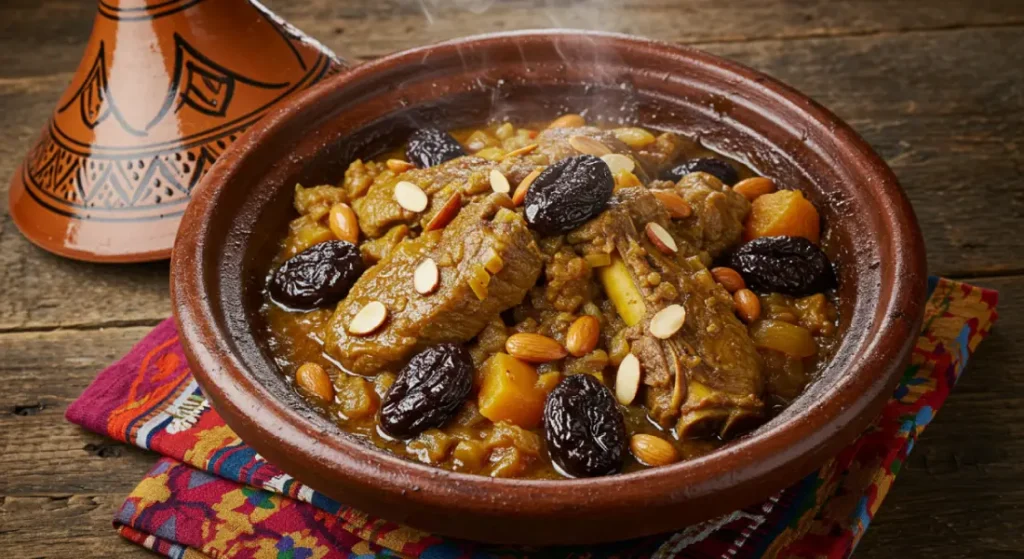
Whether it’s a vegetable tagine filled with seasonal vegetables or a lamb tagine infused with the richness of prunes and almonds, the tagine cooking method brings out the most profound flavors, making each bite a sensory journey. This slow cooking and mastery of seasoning give Moroccan cuisine its unforgettable depth and complexity.
🟦 The Cultural Connection: Moroccan Cuisine as a Celebration of Heritage
Moroccan cuisine is inseparable from its culture. Every dish reflects centuries of Berber, Arab, and Mediterranean influences, each adding its own layer to the culinary mosaic. A family meal is a time for gathering and sharing, and food is the heart of these moments.
From Fez’s lively markets to Casablanca’s cozy kitchens, food represents more than nourishment—it brings people together, tells stories, and honors tradition. Each meal celebrates heritage, offering a way to experience the diverse regions and cultures that make up Morocco.
📌 Want more inspiration? Explore our Home Page for categorized Moroccan recipes you’ll love.
🟩 How Funk and Fashion Influence Contemporary Moroccan Culinary Trends
Moroccan cuisine has always been a canvas of bold colors and flavors. Still, it has undergone a dynamic transformation in recent years that blends traditional techniques with modern creativity, just like in fashion, where vibrant patterns and daring cuts make a statement. Moroccan cuisine today embraces new ingredients, global flavors, and contemporary techniques. This fusion creates a visually exciting, flavorful, and innovative version of Morocco’s culinary legacy.
Imagine tagines garnished with pomegranate seeds for an unexpected burst of color or a classic lamb tagine reinterpreted with an avocado twist. This is a world where fusion meets tradition, where chefs and home cooks alike add funky flair to iconic Moroccan dishes, making them delicious and visually captivating.
🟨 From Street Food to Fine Dining: Moroccan Cuisine Takes a New Direction
The streets of Marrakech and Casablanca are filled with vendors selling traditional foods, but there’s a growing trend among modern chefs to reinvent street food with a refined touch. The humble Moroccan sandwich upgrades with artisan breads, fresh local herbs, and gourmet spreads, while spiced lamb sliders become a popular choice for parties and upscale events.
Chefs are also elevating Moroccan salads with creative presentations. They use quinoa or wild rice instead of traditional couscous and add herbs and zesty dressings like harissa-lime drizzle to make the dishes more vibrant and contemporary. These inventive approaches respect the flavors of Morocco but make them more accessible to an international palate.
For more inspiration, check out our detailed Moroccan Couscous recipe with a modern twist.
🟧 Funky Plating and Artful Presentation: The Visual Appeal of Moroccan Dishes
Just like in fashion, presentation is key. Moroccan chefs are masters at turning food into art. Drawing inspiration from Moroccan tilework and textiles’ geometric patterns and rich colors, they now use modern plating techniques to turn a traditional tagine or mezze platter into a visually stunning display. Playful garnishing with fresh herbs, pomegranate seeds, and edible flowers creates a sense of luxury and excitement.
The vibrant colors of saffron, turmeric, and paprika make Moroccan dishes look as exciting as they taste, while unique garnishes like toasted almonds and pickled vegetables add an extra dimension. This visual artistry invites the taste buds and the eyes to indulge in the exquisite charm of Moroccan food.
🟪 Global Influences and the Modern Moroccan Pantry
While Moroccan cuisine stays true to its roots, it embraces global ingredients and techniques. Fusing international flavors with Moroccan spices gives birth to new, exciting dishes. Quinoa, a staple in South American cuisine, is now being incorporated into Moroccan salads and tagines as a healthier alternative to couscous. Avocado, often paired with lime and cilantro, brings a creamy richness that complements the bold spices of Moroccan stews.
Chefs around the world are now looking to Moroccan cuisine for inspiration for creating comforting, colorful, and nutritious dishes while also offering innovative twists on the traditional. Healthy fats, plant-based proteins, and superfoods make Moroccan dishes perfect for the modern culinary landscape.
For more information on how Moroccan cuisine is evolving, explore this insightful article by Eater.
🟦 Funky Pairings: Combining Tradition with the Unexpected
Pairing modern ingredients with classic Moroccan dishes offers a way to explore Moroccan cuisine with a funky twist. Crispy Moroccan bastilla might be paired with fresh mango salsa, or chickpea tagine might meet a side of roasted cauliflower for an unexpected flavor combination.
For the adventurous chef, adding something as simple as lime zest, toasted quinoa, or even pistachio crumbs to a dish can elevate it from traditional to extraordinary. These small but impactful changes show that Moroccan food is not bound by its past — it’s a canvas for creativity
🟩 Why Succulent and Easy Dishes Are Perfect for Everyone
One of the most appealing aspects of Moroccan cuisine is its ability to combine rich flavors with simplicity. While the cuisine’s aromatic spices and long-standing traditions may seem intimidating initially, many dishes are surprisingly easy to prepare. The magic lies in the slow-cooking techniques and the use of quality ingredients, which work together to create succulent, tender meals that burst with flavor.
Whether you’re preparing a spicy chicken tagine or a vegetable tagine filled with seasonal produce, Moroccan dishes are all about enhancing the natural flavors of fresh ingredients. What makes these dishes so accessible is that they don’t require complicated techniques or hard-to-find ingredients. With just a few essential spices like cumin, cinnamon, and turmeric, even a beginner can quickly whip up a mouthwatering Moroccan meal.
🟨 The Magic of Slow-Cooking in Moroccan Cuisine
Slow-cooking is the secret to creating those tender, melt-in-your-mouth Moroccan dishes. Unlike fast-cooked meals, Moroccan tagines, stews, and braises allow the flavors to develop slowly over time. The moisture-locking properties of the tagine pot are central to this technique, keeping meats like lamb, chicken, or beef succulent and juicy while letting spices like ras el hanout penetrate deeply into the ingredients.
This method makes cooking more forgiving for the cook and elevates the flavors of simple ingredients. The result is a luxurious and complex dish, yet it’s straightforward to execute. Whether cooking a traditional lamb tagine with prunes or a vegetarian tagine, slow-cooking ensures that every bite is flavorful and satisfying.
For more inspiration on slow-cooked tagines, check out our guide on how to make the best Moroccan fish tagine.
🟧 Essential Ingredients for Quick and Tasty Moroccan Meals
Creating a succulent Moroccan dish doesn’t require an extensive pantry. The beauty of Moroccan cuisine lies in its simplicity — a handful of fresh herbs, a dash of citrus, and a sprinkle of aromatic spices can transform everyday ingredients into something extraordinary.
Stocking your kitchen with a few essential Moroccan ingredients is the key to making quick and tasty meals. Here’s a list of the staples that will help you build a Moroccan meal in no time:
- Olive oil is essential for cooking and brings a rich depth of flavor.
- Preserved lemons – For a tangy, zesty kick.
- Cumin – The backbone of Moroccan spice blends.
- Saffron – A touch of luxury and color.
- Cinnamon – For warmth and depth.
- Cilantro – To add freshness.
- Chickpeas – For protein-packed dishes.
With these ingredients in your pantry, you can create everything from a simple vegetable tagine to a complex spiced chicken stew.
🟪 Easy Moroccan Dishes for Busy Cooks
Moroccan cuisine is ideal for busy cooks who want to bring bold, exciting flavors without spending hours in the kitchen. Many dishes are quick to prepare and can even be made in advance, allowing you to enjoy the fruits of your labor with minimal effort.
For example, Moroccan couscous is a perfect weeknight dish — it cooks quickly and can be paired with any number of vegetables, meats, or even seafood. Similarly, a simple chickpea tagine is a hearty, comforting dish that’s both nutritious and satisfying, yet doesn’t require hours of preparation.
Moroccan cuisine simplifies. By simplifying the cooking process and focusing on key flavors, Moroccan cuisine makes it easy to create memorable meals without overwhelming your schedule. With its focus on fresh ingredients and balanced spices, Moroccan dishes are perfect for anyone looking to eat well with minimal time spent in the kitchen.
🟦 Bringing Moroccan Flavors into Your Everyday Cooking
Bringing the unique flavors of Moroccan cuisine into your everyday cooking doesn’t require a complete overhaul of your kitchen or a lot of extra effort. By incorporating key ingredients and focusing on slow cooking or easy one-pot meals, you can enjoy tender, flavorful dishes that feel special but are simple.
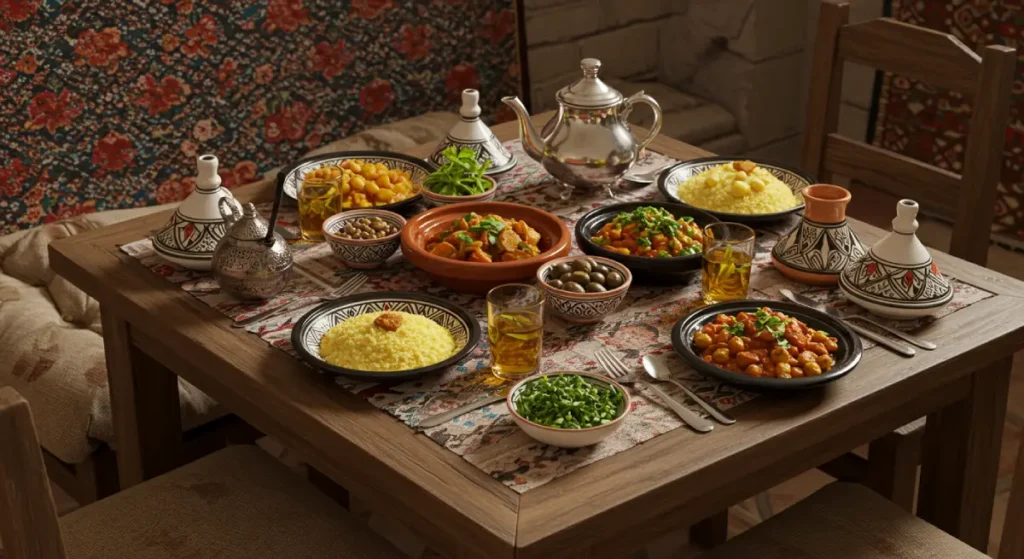
Experiment with Moroccan-inspired dishes like chicken tagine with preserved lemons or a hearty vegetable couscous. With just a little creativity and the right ingredients, you can enjoy the best of Moroccan cooking on any busy day.
To dive deeper into Moroccan flavors, try our recipe for How to Make Moroccan Hargma – A Rich & Flavorful Tagine Food, and discover another delicious dish to add to your Moroccan culinary repertoire.
For further tips on simplifying your cooking routine while exploring new flavors, you can read about how Moroccan cuisine fits into modern kitchens and busy lifestyles on Bon Appétit.
🟩 The Core Elements of Moroccan Food
Moroccan cuisine is a vibrant celebration of diverse flavors. Its uniqueness lies in the careful blend of spices, ingredients, and cooking methods passed down through generations. At the heart of Moroccan food is a rich fusion of Berber, Arab, and Mediterranean influences, each contributing its distinct flavor profile and cooking techniques to create a truly soulful culinary tradition.
Whether it’s the spicy warmth of cumin, the subtle luxury of saffron, the richness of olive oil, or the tangy burst of preserved lemons, every ingredient in Moroccan cuisine creates a dish. These core elements are essential for creating the aromatic flavors that define Moroccan meals.
🟨 Spices That Define Moroccan Cuisine
The spices used in Moroccan cuisine are its soul. Moroccan cooks have perfected the art of using these spices to create flavor-packed dishes that are balanced, aromatic, and comforting.
The most common spices include:
- Cumin – Earthy and warm- forms the base of many Moroccan dishes.
- Cinnamon – Sweet and aromatic, it adds complexity to savory and sweet dishes.
- Paprika – Slightly smoky, it enhances the depth of dishes like harira or tagine.
- Turmeric – Adds a vibrant yellow color and a subtle, slightly bitter flavor.
- Saffron – A touch of luxury, bringing a floral and earthy note to dishes.
These spices, often combined into signature blends like ras el hanout, offer Moroccan cuisine its distinct depth and complexity. Whether you’re slow-cooking a lamb tagine or adding it to a vegetarian couscous, Moroccan spices ensure that every bite is flavorful.
To learn more about Moroccan spice blends and how to use them, explore our article on How to Make the Perfect Tagine Vegetable: A Comforting Delight.
🟧 Essential Ingredients That Shape Moroccan Dishes
While spices are crucial, Moroccan cuisine is also defined by its core ingredients — staples that give the food texture, flavor, and authenticity. These ingredients form the foundation of many Moroccan dishes:
- Olive oil – Used for cooking, dressing, and adding richness to tagines and salads.
- Preserved lemons – A hallmark of Moroccan cuisine, offering a tangy, salty punch.
- Olives – Often featured in tagines, stews, and salads, adding a briny flavor that balances the richness.
- Chickpeas – A key source of protein in vegetarian tagines, soups, and salads.
- Fresh herbs – Cilantro and parsley are added at the end of cooking, providing freshness and color.
These ingredients can transform the most straightforward dish into an unforgettable Moroccan meal. The balance of sweet, salty, and spicy makes each Moroccan meal feel like a work of art.
🟪 The Influence of Berber, Arab, and Mediterranean Cultures
Moroccan cuisine is a testament to the country’s rich cultural heritage. Its culinary traditions reflect centuries of influence from various cultures, including the Berbers, Arabs, and Mediterraneans. These diverse influences are seen in both the ingredients and cooking methods.
The Berbers brought hearty stews, bread, and the art of slow cooking. The Arabs contributed spices, rice, and sweets like baklava. Meanwhile, the Mediterranean influence is evident in the abundant use of olive oil, citrus, and seafood.
This melding of cultures gives Moroccan cuisine variety and vibrancy, making it a food lover’s dream.
🟦 Moroccan Tagine: The Heart of Moroccan Cooking
The tagine is undoubtedly one of the most emblematic dishes of Moroccan cuisine. It refers to the unique clay pot used to cook stews and the rich, flavorful dishes cooked inside it. Slow-cooking in a tagine allows flavors to develop deeply, making meats incredibly tender and allowing spices to infuse the entire dish.
The versatility of tagine cooking makes it so beloved in Moroccan kitchens. From vegetable tagine to chicken tagine with preserved lemons and olives, the tagine is the heart of Moroccan food, creating unforgettable meals for friends and family to share.
For more on how Moroccan cuisine has evolved and how traditional ingredients are used creatively in modern cooking, visit this insightful article from The New York Times.
🟩 Frequently Asked Questions (FAQ)
1. What are the main ingredients in Moroccan cuisine?
Moroccan cuisine stands out for its bold and aromatic spices, which create vibrant flavors. Some essential ingredients include cumin, saffron, cinnamon, preserved lemons, olives, and olive oil. These ingredients help create the complex and bold flavors that define Moroccan food.
2. Is Moroccan food challenging to make at home?
Not at all! Many Moroccan dishes are simple to prepare once you have the right ingredients. Dishes like tagines and couscous can be made at home with just a few basic steps. A Dutch oven instead of a traditional tagine pot is an excellent option for beginners.
3. What is the best type of meat for a Moroccan tagine?
While lamb and chicken are Moroccan tagines’ most commonly used meats, you can also use beef, fish, or vegetables to create a delicious dish. Lamb tagine with prunes and chicken tagine with preserved lemons are popular choices.
4. Can I make Moroccan food in advance?
Absolutely! Many Moroccan dishes, like tagines and couscous, are even better when made ahead of time. The slow-cooking process allows the flavors to meld together, creating a more intense and satisfying taste. You can easily store these dishes and reheat them when ready to serve.
5. Is Moroccan cuisine healthy?
Yes! Moroccan cuisine is often health-conscious, focusing on fresh vegetables, lean proteins, and healthy fats from olive oil. Herbs and spices like turmeric and cinnamon also offer anti-inflammatory benefits. Many Moroccan dishes are part of the Mediterranean diet, which is widely recognized for promoting heart health and well-being.
🟩 Conclusion: Embrace the Flavorful World of Moroccan Cuisine
Moroccan cuisine celebrates vibrant flavors, aromatic spices, and rich cultural heritage. Whether you’re a seasoned cook or just starting your culinary journey, Moroccan dishes offer endless opportunities for creativity and exploration. From slow-cooked tagines to spicy couscous, each recipe invites you to experience Morocco’s warmth, soul, and tradition in your own kitchen.
The beauty of Moroccan cuisine lies in its versatility. With a few essential ingredients, you can create succulent meals that bring comfort and joy to your dining table. The funky flair of modern interpretations only adds to the excitement, making Moroccan food more accessible and enjoyable for everyone.
Now that you’ve discovered the wonders of Moroccan cuisine, it’s time to start your cooking adventure! 🌍✨
Join Us on Social Media! 🌍📱
For more inspiration, Moroccan recipes, and shared culinary moments, follow us on our social media platforms! Join our passionate community of Moroccan food lovers and share your own creations with us. You’ll find exclusive tips, recipe videos, and a chance to connect with fellow cooking enthusiasts around the world.
Subscribe to Our Newsletter! 📬✨
Stay up-to-date with the latest Moroccan recipes, cooking tips, and exclusive content straight to your inbox! By subscribing to our newsletter, you’ll receive hand-picked recipes, exciting updates, and special offers you won’t want to miss. Don’t miss out on the vibrant world of Moroccan cuisine – sign up now and be the first to know what’s cooking!
📩 Join Our Moroccan Foodie Community
Get the best Moroccan tagine recipes and seasonal culinary tips straight to your inbox.
We’d Love to Hear From You! 💬
Your thoughts and feedback mean a lot to us! If you’ve tried any of our Moroccan recipes or have any questions, feel free to leave a comment below. We love hearing about your cooking experiences and are always excited to see how you put your own spin on our dishes. Join the conversation and share your favorite Moroccan meals with us – we can’t wait to connect with you!
